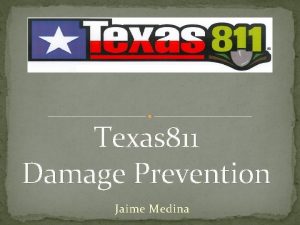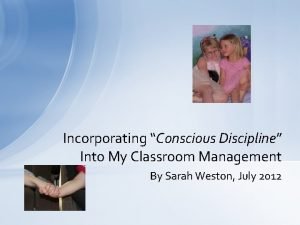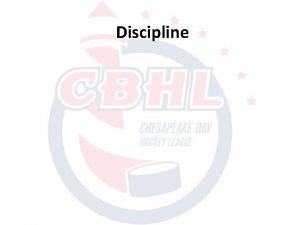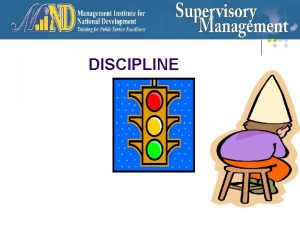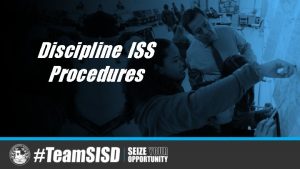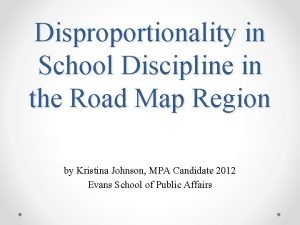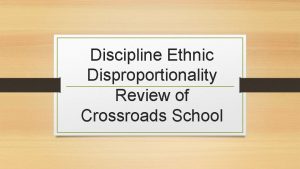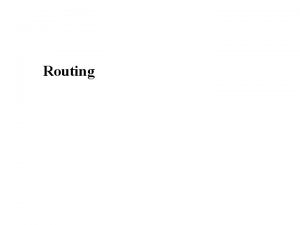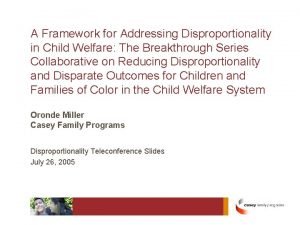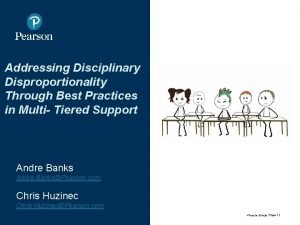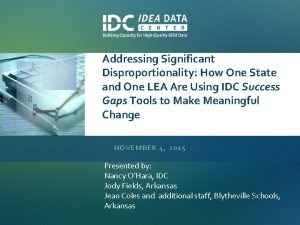Strategies for Addressing Discipline Disproportionality Texas Disproportionality Summit

































































- Slides: 65

Strategies for Addressing Discipline Disproportionality Texas Disproportionality Summit Kent Mc. Intosh University of Oregon Handouts: http: //www. pbis. org

Acknowledgements n Information from this session comes from: ¨ n Mc. Intosh, K. , Girvan, E. J. , Horner, R. H. , & Smolkowski, K. (in press). Education not incarceration: A conceptual model for reducing racial and ethnic disproportionality in school discipline. Journal of Applied Research on Children. Thanks also to ongoing work of the National PBIS Center’s Disproportionality Workgroup Clynita Grafenreed ¨ Kelsey Morris ¨ Jen Rose ¨ Russ Skiba ¨

Session Overview 1. 2. 3. 4. Describe the problem of disproportionality Share a 5 -point multicomponent intervention for reducing disproportionality Define and describe the role of implicit bias in discipline decision making Share a new set of strategies for assessing and addressing implicit bias Handouts: http: //www. pbis. org



Stop and Frisk – New York City (2004 -2012) Total Stops Successful Frisks 60% 2. 5% 50% 2. 0% 40% 1. 5% 30% 1. 0% 20% 0. 5% 10% 0% 0. 0% White Population Black Stops White Black Weapons Found Contraband Found

Disproportionality in School Discipline (Losen & Skiba, 2010)

A 5 -point Intervention to Enhance Equity in School Discipline http: //www. pbis. org/school/equity-pbis

School Discipline Guidance http: //www 2. ed. gov/policy/gen/guid/school-discipline/index. html

5 -point Intervention to Enhance Equity in School Discipline 1. 2. 3. 4. 5. Use effective instruction to reduce the achievement gap Implement SWPBIS to build a foundation of prevention Collect, use, and report disaggregated student discipline data Develop policies with accountability for disciplinary equity Teach neutralizing routines for vulnerable decision points http: //www. pbis. org/school/equity-pbis

1. Why a focus on effective academic instruction? Teacher presents student with grade level academic task Student’s academic skills do not improve Student escapes academic task Student engages in problem behavior Teacher removes academic task or removes student (Mc. Intosh et al, 2008)

What do we mean by effective academic instruction? Explicit instruction n High rates of engagement and OTRs n Quality performance feedback n Progress monitoring and data-based decision making n (Hattie, 2009)

Effects of Effective Instruction on the Achievement Gap Percent Meeting or Exceeding Standards 100% 90% 81% 84% 88% 80% 91% 43% 47% 50% 94% 11% 28% 24% 66% 67% 36% 70% 60% 94% 83% 52% 40% 38% 37% White 20% Latino 10% 0% 2007 -08 2008 -09 2009 -10 2010 -11 2011 -12 2012 -13 Tigard-Tualatin School District (Chaparro, Helton, & Sadler, in press)

2. Why use a foundation of SWPBIS? 1. 2. 3. 4. Proactive, instructional approach may prevent problem behavior and exposure to biased responses to problem behavior Increasing positive student-teacher interactions may enhance relationships to prevent challenges More objective referral and discipline procedures may reduce subjectivity and influence of cultural bias Professional development may provide teachers with more instructional responses (Greflund et al. , 2014)

Effects of SWPBIS on Discipline Disproportionality (Vincent, Swain-Bradway, Tobin & May, 2011) 25% 20% 15% SWPBIS No SWPBIS 10% 5% 0% 200506 200607 200708

5. How do we begin to address racial bias without it backfiring?

Time Out: Our options for building support 1. Show data: either theirs or national Hit them over their heads with inequities ¨ Cognitive dissonance: pattern that is not in line with our values as educators ¨ n Common Outcomes: Defensiveness ¨ Challenging validity of the data ¨ More blaming of students ¨

Time Out: Our options for building support 2. Tell people to be less biased Explain importance of equity ¨ Describe the laws on discrimination ¨ Tell people to cut it out ¨ n Common Outcomes: ¨ No change in levels of discrimination n n Don’t care Don’t have specific guidance (Girvan, 2014; Girvan et al. , 2014; Lai et al. , 2013; Pettigrew & Tropp, 2006)

Time Out: Our options for building support 3. Cultural sensitivity training Discuss value of diversity ¨ Introduce concept of White Privilege ¨ Brief introductions to various cultures ¨ n Common Outcomes: Defensiveness ¨ White people crying ¨ Shift in attitudes for some? ¨ No new strategies ¨ (Lai et al. , 2013; Pettigrew & Tropp, 2006)

Time Out: Our options for building support 4. Introduce the concept of implicit bias and provide specific strategies Describe the concept of implicit bias ¨ Explain vulnerable decision points (VDPs) ¨ Teach a self-instruction strategy ¨ 1. 2. n Am I in a VDP? If so, use an alternative response Common Outcomes: ¨ ? ? ?

Implicit Bias in School Discipline

What is implicit bias? Unconscious, automatic n Based on stereotypes n We all have it (even those affected by it) n Generally not an indication of what we believe or would endorse n More likely to influence: n ¨ Snap decisions ¨ Decisions that are ambiguous

Implicit Bias at Work n Attractiveness ¨ Real estate agents rated as more attractive sell homes for significantly higher prices (Salter, Mixon, & King, 2012) n Height ¨ One inch of height is worth $789 per year in salary (Judge & Cable, 2004)

Implicit Bias in Refereeing (Carlson, 2014)

Implicit Bias and Gender (Reuben et al. , 2014) n Subjects randomly split into groups of 4 (employers and job candidates) ¨ Job candidates paid by performance on timed math (adding sets of 2 digit numbers) ¨ Employers paid if they chose the best of 2 job candidates n Hiring criteria: ¨ Appearance ¨ Self-reported performance ¨ Actual pre-test performance

The top bars show the percentages of female candidates that were picked, and the middle bars show the percentages of times the lower-performing candidate in the pair was picked. Reuben E et al. PNAS 2014; 111: 4403 -4408 © 2014 by National Academy of Sciences

Implicit Bias and Race “the challenge is not a small number of twisted white supremacists but something infinitely more subtle and complex: People who believe in equality but who act in ways that perpetuate bias and inequality. ” -Nicholas Kristof, The New York Times


A Unidimensional View of Bias Racial Bias Disproportionate Discipline

A Multidimensional View of Bias Racial Bias Disproportionate Discipline Situation

Interventions for Implicit Bias in School Discipline

What is a Vulnerable Decision Point? A specific decision that is more vulnerable to effects of implicit bias n Two parts: n ¨ The person’s decision state (internal state) ¨ The situation

Resource Depletion (Girvan et al. , 2014) As we become fatigued, our filters for appropriate behavior can be affected n Effects of hunger (Gailliot et al. , 2009) n Decreases in willpower later in day n ¨ “The Morning Morality Effect” (Kouchaki & Smith, 2014) ¨ Examples…

Options for Identifying VDPs for Intervention Levels of specificity: 1. All ODR/suspension decisions (general self-instruction routine) 2. Identify VDPs through national data 3. Use school or district data n

n Dr. Kelsey Morris http: //www. pbis. org/school/equity-pbis

National SWIS Data (2011 -12) 3, 026, 367 ODRs 6, 269 schools 47 states, plus DC

ty 3 dy M M ct ar -T dy isu se M ta r th e Co n rty pe sic al hy ro -P -P -O 2 -T ar isu se ac t 3 M nt Co M 6 M er ro p sic al er 2 -P hy -P th M e ag gu -L an e od n t 5 M M 1 -O M tio up ec sp ss c re -D sr e isr -D Di g tin ch ea 1 M ag e gu 1 -L an e od ss c re -D M M e/ nc ef ia g/ 1 M M n tio up 9 isr 15 -D 3 ct -D ng lyi bu l Th ef t 3 es pe Di sr g tin M in Ly t/ y/ 14 M nc e/ ia 1 ef 5 ch ea ng bu lly i en m ss ra Ha 1 -D g/ t/ en m ef t Th rg er Fo ht in g Fig n tio up sr Di ct pe es sr Di gu ag e 2 Ly in ss ra y/ g 5 Ha rg er in e/ nc fia De 4 Fig ht n tio up sr 25 Di 5 ct 10 es pe sr Di ag e La n 18 16 14 12 10 8 6 4 2 0 Fo nc e/ fia De gu La n Office Referrals by Problem Behavior White 15 10 6 4 2 Black 20 21 11 7 1 3 0

ic us om Ro ry ra 3 M ke r ay w 0 Lib ze m 5 Lo c ee Gy 1 Br ab r. L s m ea Ar te pu on oo ia er 0 ll/ m Co m m Co as sr Cl e 5 Ha s/ on m fe t 60 1 Ro om Of f-C am pu s Of Ot fic he e r. L oc at Sp io ec n P ar ia l. E kin ve g. L nt ot /A Pl ay ss g em ro un bl y/ d Fie ld tri p Un St a kn di ow um n L oc Vo at ca io tio n na l. R oo m m Co 2 on s Bu 10 Ca g. Z di n om m oo tro es /R t. R Ar 1 Bu s. L oa om ro th Ba Office Referrals by Location 70 56 50 40 30 20 Black White 7 9 0 0 1 1 3 2 0 0 0 1 0

12: 00 AM 12: 30 AM 1: 00 AM 1: 30 AM 2: 00 AM 2: 30 AM 3: 00 AM 3: 30 AM 4: 00 AM 4: 30 AM 5: 00 AM 5: 30 AM 6: 00 AM 6: 30 AM 7: 00 AM 7: 30 AM 8: 00 AM 8: 30 AM 9: 00 AM 9: 30 AM 10: 00 AM 10: 30 AM 11: 00 AM 11: 30 AM 12: 00 PM 12: 30 PM 1: 00 PM 1: 30 PM 2: 00 PM 2: 30 PM 3: 00 PM 3: 30 PM 4: 00 PM 4: 30 PM 5: 00 PM 5: 30 PM 6: 00 PM 6: 30 PM 7: 00 PM 7: 30 PM 8: 00 PM 8: 30 PM 9: 00 PM 9: 30 PM 10: 00 PM 10: 30 PM 11: 00 PM 11: 30 PM Office Referrals by Time of Day White 9. 0 8. 0 7. 0 6. 0 5. 0 4. 0 3. 0 2. 0 1. 0 0. 0 Black 9. 0 8. 0 7. 0 6. 0 5. 0 4. 0 3. 0 2. 0 1. 0 0. 0

VDPs from national ODR data y t i u g i b m a ¨ Disruption, defiance, major vs. minor t c a t n o c n Non-classroom areas F O K C ¨ Hallways LA n Subjective problem behavior n Afternoons e u g i fat

Multidimensional View of Bias Racial Bias Disproportionate Discipline Situation Vulnerable Decision Points Subjective Behavior Hunger Vague Discipline System Fatigue Common Areas Unfamiliar with Student

School Example Urban K-8 School

Risk Indices n Black/White ODR Risk Ratio = 2. 5

Problem Behavior: All Students

Problem Behavior: Black Students Only

Drill Down: Physical Aggression n Black/White ODR Risk Ratio = 6. 5

Drill Down: Physical Aggression Playground

Addressing Common Questions “Isn't it all really about poverty? ” n Poverty plays a role, but racial disproportionality remains, even when controlling for poverty ¨ American Psychological Association, 2008 ¨ Skiba et al. , 2005 ¨ Wallace et al. , 2008

Addressing Common Questions “Aren’t Black boys just more violent? ” n No evidence of different base rates of behavior for any subgroups ¨ Bradshaw et al. , 2010 ¨ Losen & Skiba, 2010 ¨ Skiba et al. , in press

Addressing Common Questions “Are you saying that all teachers are racist? ” n No! Our research indicates that disproportionality comes from unconscious bias – that we’re not even aware of. ¨ Banaji & Greenwald, 2013 ¨ Greenwald & Pettigrew, 2014 ¨ van den Bergh et al. , 2010

Two-step Neutralizing Routine for Staff: When you see problem behavior, stop and ask yourself: 1. Is this a VDP? n Situation ¨ Decision state ¨ 2. If so, use an agreed-upon alternative response

Neutralizing Routines for Reducing Effects of Implicit Bias Self-assessment “Is this a vulnerable decision point? ” Setting event Lack of positive interactions with student Fatigue Antecedent Loud complaints about work (subjective behavior) Behavior Consequence Send student to office (ODR) Student leaves class (Escape social interaction) Alternative Response “See me after class. ”

What makes for a good neutralizing routine? Brief n If-then statements n Clear steps n Doable n

What makes for a good alternative response? n Delay ¨ “See me after class” n Pause ¨ Think it through before sending to office n Use least exclusionary choice ¨ Delayed ODR n Speak with student ¨ State your confidence in them ¨ Ask about their needs privately

Neutralizing Routine Examples “If this is a VDP, am I acting in line with my values? ” n “If disrespect, keep in class” n “If I am tired, delay decision until I can think clearly” n

Two-step Neutralizing Routine for Staff: Can also be used as precorrection 1. Am I about to enter a VDP? 2. What are my values? 3. When I see problem behavior, I’ll use the alternative response n

Two-step Neutralizing Routine for Administrators: (Susan Barrett) When you have to handle problem behavior, stop and tell yourself: 1. Don’t just do something, stand there! n Be sure you are ready to act in line with values ¨ Get information from student and staff ¨ Assess student-teacher relationship ¨ 2. Whenever possible, use an agreed-upon instructional response Teaches missing skills ¨ Connects student to school and staff ¨

The Restorative Chat (Alton School District, Alton, IL) 1. 2. 3. 4. 5. 6. 7. Tell me what happened. What you were thinking at the time? What do you think about it now? Who did this affect? What do you need to do about it? How can we make sure this doesn't happen again? What I can do to help you?

Professional Development 1. Use data to identify: ¨ The extent of the problem ¨ Vulnerable Decision Points (VDPs) 2. Teach and practice: ¨ Implicit bias ¨ VDPs ¨ Neutralizing routines 3. Follow up: ¨ Ongoing coaching ¨ Monitor progress with data

Contact Information n Kent Mc. Intosh Special Education Program University of Oregon kentm@uoregon. edu @_kentmc Cannon Beach, Oregon © Go. Pictures, 2010 Handouts: http: //kentmcintosh. wordpress. com

References American Psychological Association. (2008). Are zero tolerance policies effective in the schools? An evidentiary review and recommendations. American Psychologist, 63, 852 -862. Anand, R. , & Winters, M. (2008). A retrospective view of corporate diversity training from 1964 to the present. Academy of Management Learning & Education, 7, 356 -372. Bradshaw, C. P. , Mitchell, M. M. , O'Brennan, L. M. , & Leaf, P. J. (2010). Multilevel exploration of factors contributing to the overrepresentation of black students in office disciplinary referrals. Journal of Educational Psychology, 102, 508 -520. Chaparro, E. A. , Helton, S. , & Sadler, C. A. (in press). Oregon Effective Behavioral and Instructional Support Systems initiative: Implementation from district and state level perspectives. In K. Mc. Intosh & S. Goodman (Eds. ), Multi-tiered systems of support: Integrating academic RTI and school-wide PBIS. New York: Guilford.

References Gailliot, M. T. , Peruche, B. M. , Plant, E. A. , & Baumeister, R. F. (2009). Stereotypes and prejudice in the blood: Sucrose drinks reduce prejudice and stereotyping. Journal of Experimental Social Psychology, 45, 288 -290. Girvan, E. J. (2014). Wise restraints? : How learning the law affects socially-biased decision-making. How Learning the Law Affects Socially-Biased Decision-Making (June 4, 2013) (available at SSRN: http: //ssrn. com/abstract=2274314) Girvan, E. J. , Deason, G. , & Borgida, E. (2014). The generalizability of gender bias: Effects of expertise and accountability on sexism in labor arbitration decisions. Manuscript submitted for publication. Greenwald, A. G. , & Pettigrew, T. F. (2014). With malice toward none and charity for some: Ingroup favoritism enables discrimination. American Psychologist, 69, 669 -684.

References Greflund, S. , Mc. Intosh, K. , Mercer, S. H. , & May, S. L. (2014). Examining disproportionality in school discipline for Aboriginal students in schools implementing PBIS. Canadian Journal of School Psychology, 29, 213 -235. Judge, T. A. , & Cable, D. M. (2004). The effect of physical height on workplace success and income: preliminary test of a theoretical model. Journal of Applied Psychology, 89, 428 -441. Kahneman, D. (2011). Thinking, fast and slow. New York: Macmillan. Kouchaki, M. , & Smith, I. H. (2014). The morning morality effect: The influence of time of day on unethical behavior. Psychological Science, 25, 95 -102. doi: 10. 1177/0956797613498099 Lai, C. K. , Hoffman, K. M. , Nosek, B. A. , & Greenwald, A. G. (2013). Reducing implicit prejudice. Social and Personality Psychology Compass, 7, 315 -330. Losen, D. J. , & Skiba, R. J. (2010). Suspended education: Urban middle schools in crisis. Montgomery, AL: Southern Poverty Law Center.

References Mc. Intosh, K. , Girvan, E. J. , Horner, R. H. , & Smolkowski, K. (in press). Education not incarceration: A conceptual model for reducing racial and ethnic disproportionality in school discipline. Journal of Applied Research on Children. Mc. Intosh, K. , Barnes, A. , Morris, K. , & Eliason, B. M. (2014). Using discipline data within SWPBIS to identify and address disproportionality: A guide for school teams. Eugene, OR: Center on Positive Behavioral Interventions and Supports. University of Oregon. Pettigrew, T. F. , & Tropp, L. R. (2006). A meta-analytic test of intergroup contact theory. Journal of Personality and Social Psychology, 90, 751. Reuben, E. , Sapienza, P. , & Zingales, L. (2014). How stereotypes impair women’s careers in science. Proceedings of the National Academy of Sciences, 111, 4403 -4408. Salter, S. P. , Mixon Jr, F. G. , & King, E. W. (2012). Broker beauty and boon: a study of physical attractiveness and its effect on real estate brokers’ income and productivity. Applied Financial Economics, 22, 811825.

References Skiba, R. J. , Chung, C. G. , Trachok, M. , Baker, T. , Sheya, A. , & Hughes, R. L. (in press). Where should we intervene? How infractions, students, and schools all contribute to out-of-school suspension. In D. J. Losen (Ed. ), Closing the school discipline gap: Research for policymakers. New York: Teachers College Press. Skiba, R. J. , Michael, R. S. , Nardo, A. C. , & Peterson, R. L. (2002). The color of discipline: Sources of racial and gender disproportionality in school punishment. The Urban Review, 34, 317 -342. doi: 10. 1023/A: 1021320817372 Staats, C. (2014). State of the science: Implicit bias review 2014. Columbus, OH: Kirwan Institute. Vincent, C. G. , Swain-Bradway, J. , Tobin, T. J. , & May, S. (2011). Disciplinary referrals for culturally and linguistically diverse students with and without disabilities: Patterns resulting from school-wide positive behavior support. Exceptionality, 19, 175 -190. Wallace, J. M. J. , Goodkind, S. , Wallace, C. M. , & Bachman, J. G. (2008). Racial, ethnic, and gender differences in school discipline among U. S. high school students: 1991– 2005. Negro Educational Review, 59, 47 -62.
 Flat addressing vs hierarchical addressing
Flat addressing vs hierarchical addressing Texas fatherhood summit
Texas fatherhood summit Texas 811 portal
Texas 811 portal Conscious discipline breathing strategies
Conscious discipline breathing strategies Tack för att ni har lyssnat
Tack för att ni har lyssnat Personlig tidbok
Personlig tidbok Rutin för avvikelsehantering
Rutin för avvikelsehantering Vad är vanlig celldelning
Vad är vanlig celldelning Iso 22301 utbildning
Iso 22301 utbildning Myndigheten för delaktighet
Myndigheten för delaktighet Presentera för publik crossboss
Presentera för publik crossboss Kung som dog 1611
Kung som dog 1611 Att skriva en debattartikel
Att skriva en debattartikel Tobinskatten för och nackdelar
Tobinskatten för och nackdelar Tack för att ni har lyssnat
Tack för att ni har lyssnat Hur ser ett referat ut
Hur ser ett referat ut Frger
Frger Fimbrietratt
Fimbrietratt Varför kallas perioden 1918-1939 för mellankrigstiden
Varför kallas perioden 1918-1939 för mellankrigstiden Byggprocessen steg för steg
Byggprocessen steg för steg Rådet för byggkompetens
Rådet för byggkompetens Vätsketryck formel
Vätsketryck formel Tallinjen
Tallinjen Elektronik för barn
Elektronik för barn Borra hål för knoppar
Borra hål för knoppar A gastrica
A gastrica Smärtskolan kunskap för livet
Smärtskolan kunskap för livet Bris för vuxna
Bris för vuxna Argument för teckenspråk som minoritetsspråk
Argument för teckenspråk som minoritetsspråk Novell typiska drag
Novell typiska drag Trög för kemist
Trög för kemist Delegerande ledarskap
Delegerande ledarskap Humanitr
Humanitr Toppslätskivling dos
Toppslätskivling dos Redogör för vad psykologi är
Redogör för vad psykologi är Mat för unga idrottare
Mat för unga idrottare Ramsa geometriska former
Ramsa geometriska former Bästa kameran för astrofoto
Bästa kameran för astrofoto En lathund för arbete med kontinuitetshantering
En lathund för arbete med kontinuitetshantering Ledarskapsteorier
Ledarskapsteorier Publik sektor
Publik sektor Vad är lyrik
Vad är lyrik Fredsgudinna
Fredsgudinna Orubbliga rättigheter
Orubbliga rättigheter Steg för steg rita
Steg för steg rita Vad är densitet
Vad är densitet Ministerstyre för och nackdelar
Ministerstyre för och nackdelar Bamse för de yngsta
Bamse för de yngsta Vem räknas som jude
Vem räknas som jude Nationell inriktning för artificiell intelligens
Nationell inriktning för artificiell intelligens Sju principer för tillitsbaserad styrning
Sju principer för tillitsbaserad styrning Nyckelkompetenser för livslångt lärande
Nyckelkompetenser för livslångt lärande Romarriket tidslinje
Romarriket tidslinje Mästar lärling modellen
Mästar lärling modellen Matematisk modellering eksempel
Matematisk modellering eksempel Underlag för särskild löneskatt på pensionskostnader
Underlag för särskild löneskatt på pensionskostnader Verktyg för automatisering av utbetalningar
Verktyg för automatisering av utbetalningar Vishnuismen
Vishnuismen Cks
Cks Cellorov
Cellorov I gullregnens månad
I gullregnens månad Strategi för svensk viltförvaltning
Strategi för svensk viltförvaltning Boverket ka
Boverket ka Verksamhetsanalys exempel
Verksamhetsanalys exempel Formel gruplar
Formel gruplar Datorkunskap för nybörjare
Datorkunskap för nybörjare


